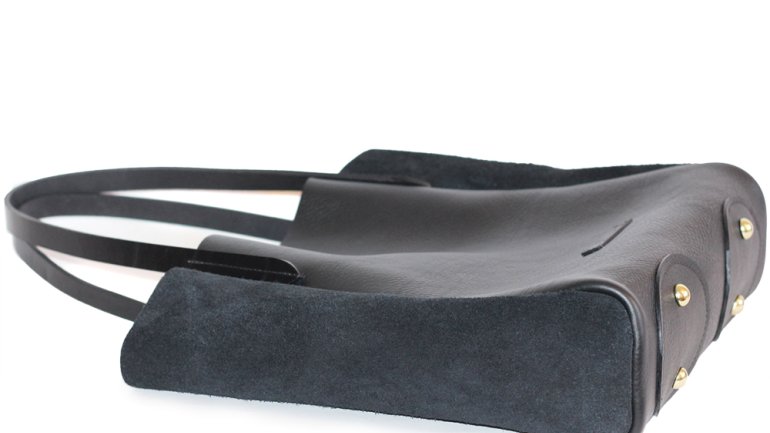Heavy Duty
Heavy Duty
Libby Lane, creator of gorgeous leather handbags, wields some pretty terrifying tools over the course of an average workday. “I use a hammer 50 times a day, and blades,” she says. “And I have a hydraulic clicker. It’s a 20-ton, pressured machine that comes down like a cookie-cutter for leather. It will cut your arm off, but it’s amazing.”
Lane, 27, grew up on a working cattle ranch outside Amarillo, Texas, where imposing machinery was the norm. “Being from Texas, I was really surrounded by chaps and boots and saddles from an early age,” Lane says. She particularly liked to observe some third-generation saddle makers in their shop, where she could comfortably ogle their enormous hydraulic clicker.
Lane headed north for college, majoring in fashion design at the School of the Art Institute of Chicago. She quickly began experimenting with flat patterns — for example, creating a free-form wearable that wrapped around the body. “I think my teachers were kind of worried,” she says. “It was not the typical fashion thing.”
Then came a sequence of clarifying moments. She visited a tannery in Chicago. She started experimenting with deer hides. She bought a bundle of hides from a traveling fur trader. She toyed with leather apparel, leather shoes, even some early incarnations of her beloved leather handbags. “I had been feeling a little lost,” she says of her early college days. “But everything connected when I started working with leather.”
After graduating in 2009, Lane set aside these projects and headed for New York City to pursue a career in fashion and design. It ended up as a period of more soul-searching and experimentation. She worked with a prop stylist and a clothing stylist. She shadowed a textile designer at the Knoll furniture company. She admired the work of “really contemporary, off-the-wall” fashion brands including Proenza Schouler and Marni.
But something was off. “I missed using my hands,” she remembers. On weekend trips and holidays back in Texas, she was still calling upon those saddle makers, still admiring their industrial machines and their labor-intensive craft. “So I started making these carryall totes,” says Lane.
Her first tote coincided with a return to Texas in 2011. She launched her Libby Lane brand six months after coming home. “I never had any space to build in New York,” says Lane, who set up shop in an old bunkhouse for the cowboys who used to work her family’s 3,000-acre property (which still operates as a cattle ranch). “My place out here is really peaceful and quiet. And I have a huge, really cool space that inspires me.”
Which is a good thing, because Lane requires plenty of space for her craft. She needs room for that hydraulic clicker, plus she needs long tables for inserting hardware and hand-cutting all of her straps. “These hides are huge – 8 feet long, and really heavy,” she explains. Her average output is about six handbags per week.
Lane also selects every piece of leather herself, though she favors the leathers created for Red Wing Shoes in Minnesota. “These hides are so inspiring,” she says. “Most of them are brown, tan, black, red-brown. The colors are very natural. And I like the thickness, because I don’t line any of my stuff. I want to keep it very simple.”
“This will sound a bit overdone, but the bag grabbed me emotionally,” says Kaara Ettesvold, a two-time customer from Washington, D.C., who first happened upon a Libby Lane clutch while flipping through a fashion magazine. “It was simple. It was elegant. It was made in the United States.”
If customers like Ettesvold knew of the machinery and tools employed for these bags “they would be shocked a woman was doing it,” says Lane, a five-foot-four, 110-pound craftsperson who admits to occasionally calling in help from the local menfolk.
“It’s kind of a man’s world,” she continues. “Which is so interesting, because I’m building these bags that complement women.”
Christy DeSmith is a Minneapolis-based freelance writer.

